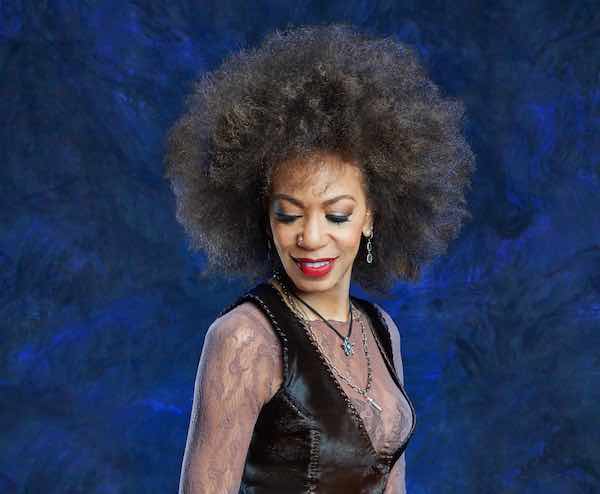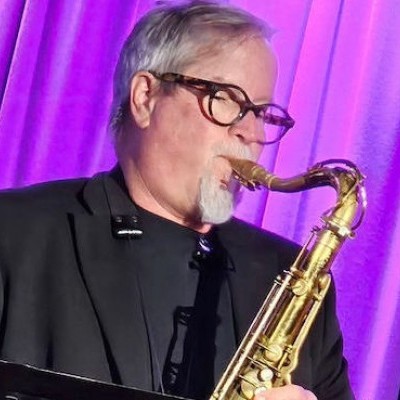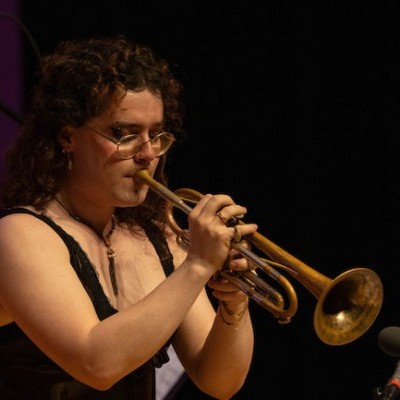Oct 28, 2025 10:47 AM
In Memoriam: Jack DeJohnette, 1942–2025
Jack DeJohnette, a bold and resourceful drummer and NEA Jazz Master who forged a unique vocabulary on the kit over his…

The fusion of musical ideas on Cindy Blackman Santana’s latest album “transcends any kind of veil that we put between us,” the drummer said.
(Photo: Maryanne Bliham)When drummer and bandleader Cindy Blackman Santana makes music, it’s in pursuit of something deeply spiritual.
Soulfulness has defined Blackman Santana’s playing since her breakout in the mid-1980s, and it’s the lifeblood of Give The Drummer Some, her joyful new jazz-fusion record featuring a cast of A-listers, including her husband of 10 years, Carlos Santana.
Growing up in Yellow Springs, Ohio, Blackman Santana attributes her early attraction to the drums to something divine. As a toddler, her mother would find Blackman Santana patting out rhythms on whatever household objects were around. After begging for years, she was gifted a drum set at the age of 7.
“[My mother] thought I would outgrow it,” Blackman Santana said. “But I never did. ... I think it is something that my soul has always wanted to do.”
Owning her own kit opened up a new world for her, the drummer said, especially after she found Miles Davis and Ahmad Jamal records in her father’s collection, offering up an inkling of what was possible on the instrument.
In her early twenties, after studying at Berklee School of Music, Blackman Santana moved to New York and started catching performances of such drum heroes as Tony Williams, Elvin Jones and Art Blakey. Remarkably, she became close enough with Blakey to call him “Papa” and babysit his kids. She also received a special gift from Jimmy Cobb—the cymbal he’d received from Williams years earlier when the younger drummer joined Davis’ quintet.
While Blackman Santana clearly earned her straightahead jazz stripes—as her blistering, dynamic and polyrhythmic percussion feature on Give The Drummer Some’s “Mother Earth” so readily conveys—the new record truly is a fusion effort. Consisting mostly of the bandleader’s originals, the album highlights Blackman Santana’s adaptability, garnered from her years in Lenny Kravitz’s band, as well as her experience supporting an array of artists from soul singer Joss Stone to avant-metal guitarist Buckethead.
While several tracks on the album, like the sassy “She’s Got It Goin’ On,” were shaped to be radio-friendly, others, like “Miles Away,” exist comfortably outside of the pop world.
Her ability to blend genres also highlights a spiritual approach to the music. Though Blackman Santana became a member of the Bahá’í faith in her teens and has studied Kabbalah, her current mode of spirituality is a nondenominational one, based in removing encumbrances, and finding truth and love through music.
“I feel that music, in general, is the supreme communicator, which crosses all barriers that human beings have implemented upon ourselves around the world ... . [M]usic touches people and it just transcends any kind of veil that we put between us,” she said. “If you look at everything from a spiritual perspective, then we’re not going to have the issues that we have, you know? We won’t hate on each other, we won’t hurt each other, we won’t fight each other.”
This philosophy not only imbues Give The Drummer Some with a sense of transcendence, but of celebration and communion with listeners and with other musicians featured on the album.
John McLaughlin, the jazz-fusion pioneer who first connected with Blackman Santana on stage at the 2011 Montreux Jazz Festival, describes playing music with the drummer as “taking a walk in the cosmos.” They embark on a transcendent stroll when McLaughlin appears on “We Came To Play,” a fierce riff-based rock tune anchored in an improvisational tête-à-tête between the guitarist and bandleader.
The joyful bond between Blackman Santana and her husband is conveyed on the celebratory “Fun Party Splash,” the guitarist’s high-energy soloing meeting Blackman Santana’s raucous drumming and smoky voice, as she sings, “Have no fear/ Love is here.”
Even on songs that might not seem overtly light, like “Social Justice” and “Change Is In Your Hands,” Blackman Santana remains focused on love and connection. It’s one of the aspects of the 17-track record that her husband most adores.
“The album has the frequency vibration and energy to heal people, because a lot of people need hope and courage; a lot of people need the opposite of doom and gloom,” the guitarist said. “This album, to me, it’s like a sweet pinch.” DB
This story originally was published in the November 2020 issue of DownBeat. Subscribe here.

Jack DeJohnette boasted a musical resume that was as long as it was fearsome.
Oct 28, 2025 10:47 AM
Jack DeJohnette, a bold and resourceful drummer and NEA Jazz Master who forged a unique vocabulary on the kit over his…

“I’ve told students, ‘I don’t mind if you use AI for this or that project,’” says MIT’s Pascal Le Boeuf. “‘But you need to tell me.’”
Sep 18, 2025 11:14 AM
A standard joke when it comes to discussing artificial intelligence, or AI, is that it’s developing so rapidly that…

Chuck Manning Works for NASA … and plays jazz.
Sep 18, 2025 11:23 AM
Congratulations! After years of study, you’ve earned your degree in jazz performance. But let’s face it: Making a…

Always a sharp dresser, Farnsworth wears a pocket square given to him by trumpeter Art Farmer. “You need to look good if you want to hang around me,” Farmer told him.
Sep 23, 2025 11:12 AM
When he was 12 years old, the hard-swinging veteran drummer Joe Farnsworth had a fateful encounter with his idol Max…

“Make time and energy to meet people and make friends,” suggests Millie Ahearn, a student at DePaul University.
Sep 18, 2025 11:32 AM
For many students, the transition into a collegiate jazz program can feel overwhelming — new peers, unfamiliar…